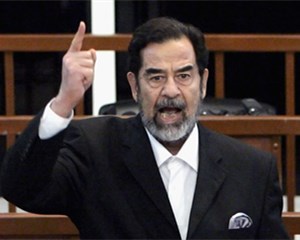After the Gulf war in 1991, sanctions imposed by the international community banned all trade with Iraq except in humanitarian circumstances. Among many hardships, this made it difficult for artists and sculptors to access materials. One way to get paint, canvas, bronze and stone was to paint pictures or make sculptures of Saddam. If the art was right, the regime would provide. While the Iraqi people suffered under sanctions, Saddam built vast palaces filled with monuments to himself. It is unclear how many statues of himself Saddam put up in this period, though there were hundreds in Baghdad alone.
1991年海灣戰(zhàn)爭(zhēng)后,國(guó)際社會(huì)實(shí)施制裁,禁止與伊拉克進(jìn)行除人道主義之外的所有貿(mào)易。面對(duì)這些困難,藝術(shù)家們和雕塑家們很難獲得材料。而有一種辦法可以拿到顏料、畫布、青銅和石頭,那就是為薩達(dá)姆畫像或雕刻雕像。政府只支持正確的藝術(shù)。當(dāng)伊拉克人民飽受制裁之苦時(shí),薩達(dá)姆建造了巨大的宮殿,里面全是他自己的紀(jì)念碑。雖然僅在巴格達(dá)就有數(shù)百座薩達(dá)姆雕像,但目前尚不清楚在這一時(shí)期建造了多少座薩達(dá)姆雕像。
There was nothing special about the statue of Saddam that was put up in Firdos Square in April 2002 to mark his 65th birthday. Firdos Square is not the most important location in Baghdad, and the statue was unexceptional: a bronze standing figure, 12 metres high, weighing around a tonne. The fact that it was not a big deal may be one reason why, since its destruction, there has been confusion as to who made it.
2002年4月,為紀(jì)念薩達(dá)姆65歲生日,政府在佛多斯廣場(chǎng)建造了一座薩達(dá)姆雕像,這座雕像并沒有什么特別之處。佛多斯廣場(chǎng)并不是巴格達(dá)最重要的地方,而這座雕像也很普通:一座高12米、重約1噸的青銅雕像。也許就是因?yàn)樗芷胀ǎ宰运淮輾б詠恚藗円恢睂?duì)建造它的人感到困惑。

At least two different sculptors have been credited with creating this statue, with two different narratives. This is characteristic of the story of Saddam's statue in Firdos Square. The boundary between what is real and what is fake would soon disappear altogether.
至少有兩位不同的雕刻家參與建造了這座雕像,關(guān)于它的故事有兩種版本。這就是佛多斯廣場(chǎng)薩達(dá)姆雕像故事的特點(diǎn)。真假之間的界限很快就會(huì)完全消失。
The French philosopher Jean Baudrillard defined hyperreality as a state in which you cannot tell the difference between reality and a simulation of reality. In 1991, at the time of the first Gulf war, he wrote three essays touching on this theme, later published together as The Gulf War Did Not Take Place. Baudrillard argued that the relevant events in the first couple of months of 1991 were not really a war, in the sense that "war" was commonly understood: they were a simulation of a war.
法國(guó)哲學(xué)家讓·鮑德里亞將超現(xiàn)實(shí)定義為一種無法區(qū)分現(xiàn)實(shí)和模擬現(xiàn)實(shí)的狀態(tài)。1991年第一次海灣戰(zhàn)爭(zhēng)爆發(fā)時(shí),他寫了三篇關(guān)于該主題的文章,后來一起發(fā)表為《海灣戰(zhàn)爭(zhēng)沒有發(fā)生》。鮑德里亞認(rèn)為,1991年前幾個(gè)月的相關(guān)事件并不是一場(chǎng)真正的戰(zhàn)爭(zhēng),就“戰(zhàn)爭(zhēng)”這個(gè)概念而言:它們是一場(chǎng)模擬戰(zhàn)爭(zhēng)。











